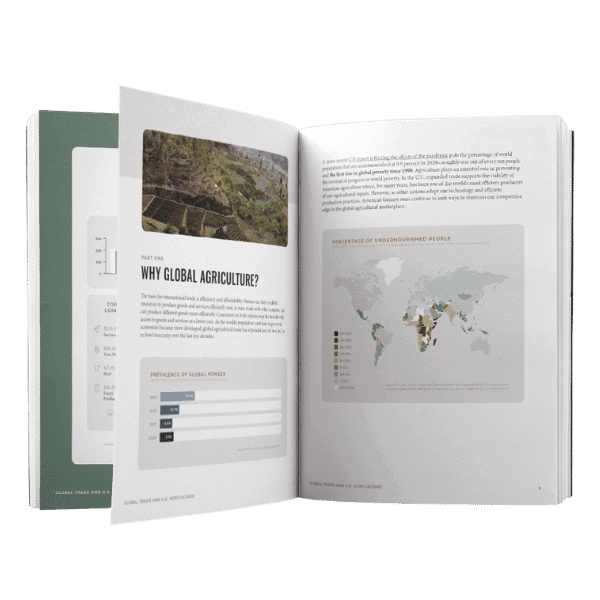Third Quarter Update: 2021-2022 Trade Outlook for U.S. Agriculture
The third quarter USDA ERS Trade Forecast Report was filled with record-breaking forecasts and (mostly) good news for U.S. ag export trade.
The third quarter USDA trade outlook compounded on good news from the second quarter trade report by forecasting a strong second half of 2021 for U.S. agricultural trade that will likely carry into 2022. For fiscal year (FY) 2021, U.S. ag export sales increased by $9.5 billion since May’s forecast to $173.5 billion. Projections for FY 2022 aim even higher at an estimated $177.5 billion.

The increase in U.S. ag export trade forecast is attributed to two key factors. First, record-level increases for soybeans, cotton, and horticultural products. Second, the ERS’ decision to adopt the World Trade Organization’s definition of agricultural products. Under this revised definition, the following commodities were added and removed:
Included commodities
- Ethanol;
- Distilled spirits;
- Industrial alcohols and fatty acids;
- Mineral and aerated waters;
- Dextrins, peptones, and proteins;
- Manufactured tobacco;
- Misc. animal products;
- Live animals;
- Cotton waste; and
- Misc. plant material.
Removed commodities
- Enzymes, penicillin, and similar preps;
- Lecithin and industrial acids;
- Donated food products for relief;
- Rubber, jute, and misc. plant fibers; and
- Rennet.
Ultimately, this change led to an average year-over-year increase of $4.7 billion in U.S. ag exports and a $9.9 billion increase in imports. Even when taking this net effect into consideration, the FY 2021/2022 trade forecast still sets news records for U.S. ag trade.
Report Highlights: U.S. Agricultural Global Trade Forecast
Exports
Soybeans, horticultural products, cotton, dairy, and poultry product sales were among the highest projected increases in exported ag commodities. Soybeans and horticultural products hit record growth projections at $32.3 billion and $37.7 billion, respectively. Cotton export sales are estimated to hit the highest level in a decade at $6.8 billion, due to higher unit values and stronger projected demand and consumption. Dairy and poultry products are estimated to increase $600 million collectively for the remaining FY 2021 and $300 million in FY 2022. Beef exports are up $800 million for FY 2021. However, a $100 million decline is estimated in 2022, due in part to lower production rates in the second half of 2021 along with growing competition from Brazilian beef exports.
Imports
The revised ag imports forecast for FY 2021 sits at $157.5 billion, a $15.7 billion increase from May’s forecast. The FY 2022 forecast is $2 billion higher at $159.5 billion. The substantial increase in projected import trade is mostly attributed to pent-up demand from COVID-related shutdowns and increasing entertainment and service industry sales, in turn, driving up the prices of wine, beer, fruits, vegetables, and horticultural products.
Trade Partnerships
Phase one of the U.S.-China trade agreement established that over the course of 2020 and 2021, total exports of U.S. agricultural products to China would increase by $73 billion. Agricultural exports to China are forecasted at $37 billion in FY 2021 and $39 billion in 2022, largely due to higher expected soybean prices and strong cotton and sorghum demand. While substantial, these are still below the 2021 obligation of $43.6 billion in U.S. ag purchases. Much uncertainty remains on how the trade partnership will be handled once the phase one agreement expires in January 2022. Agricultural exports to Canada and Mexico increased for both FY 2021 and 2022. Increased trade to Canada is attributed to higher sales of horticultural products while increased trade to Mexico is attributed to higher-than-expected exports of fruits, vegetables, and dairy. This is the first trade outlook for U.S. agriculture report that separated the European Union and United Kingdom trade data, showing a combined increase of $1.2 billion for U.S. ag exports, due mostly to ethanol and distilled spirits. The European Union also took Canada’s place as the second-largest supplier of ag goods to the U.S. at $31.5 billion, closely behind Mexico—our top supplier at $35.5 billion.
The Economic Outlook for U.S. Agricultural Trade in 2022
The COVID-19 pandemic remains the primary factor influencing global economic activity as we head into 2022. Pandemic-induced supply chain disruptions continue to elevate shipping prices and create logistical backlogs. Through it all, world real gross domestic product (GDP) is projected to increase by 5.7 percent for the remainder of 2021 and increase by 4.6 percent in 2022. In the U.S., real GDP growth has risen by 0.4 percent to 6.2 percent in 2021. Relatively higher interest rates compared to other advanced economies are expected to support the U.S. dollar during the rest of 2021. However, the weighted dollar of U.S. agricultural exports is anticipated to depreciate by an estimated 2.4 percent in 2021, suggesting American farmers may have more competitive prices in the global market in the coming year, while foreign import prices could increase slightly.
Download your free copy of Global Trade and U.S. Agriculture to learn more about the factors currently influencing the global trade market for U.S. agriculture and what farmers should be keeping an eye on in 2022.

You can also visit AgAmerica’s Agricultural Economics Page to find more insights from Chief Economist Dr. John Penson.






